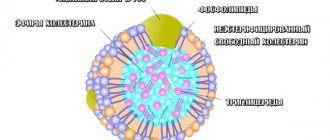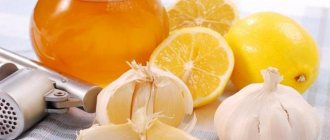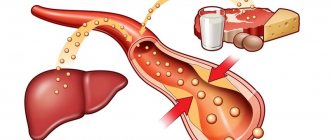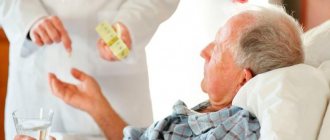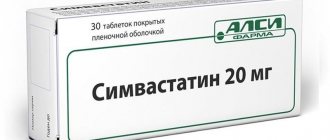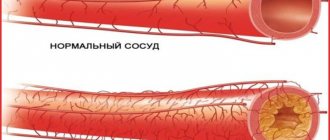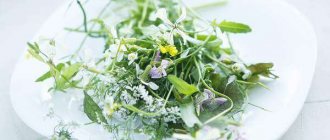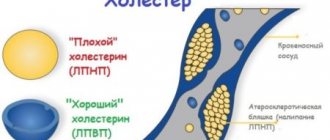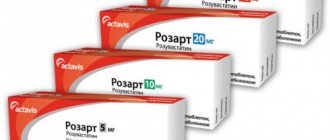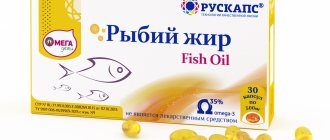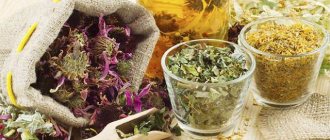High cholesterol levels (hypercholesterolemia) inevitably entail various cardiovascular pathologies. To reduce dangerous values, statins, a special group of medications, are used. Like other drugs, statins have contraindications and side effects. Not all patients know that natural statins exist.
The list of products that contain them is wide and accessible to every patient; it does not contain exotic elements. Is it possible to give up pills and normalize fat metabolism on your own by eating the right foods?
How do statins affect cholesterol levels?
Most (up to 80%) of cholesterol is formed in the liver. Only a small amount (not exceeding 20%) comes with food. Cholesterol is necessary for fat metabolism, but its excess leads to atherosclerosis.
Drugs containing statins help with high cholesterol levels: they reduce its production by liver cells. This significantly reduces the formation of plaques and minimizes the risk of cardiovascular pathologies.
However, treatment with enzyme statins has its drawbacks. Since the therapy is designed to be taken continuously over several years, unwanted side effects may occur. Elderly people often experience exacerbations of chronic diseases.
The muscle fibers are most affected: constant use of pills can cause myopathy. This condition is accompanied by pain, which significantly reduces the patient’s standard of living.
If you do not stop taking it, muscle breakdown and blockage of the kidney channels will begin. This leads to acute renal failure. This is why you should not start taking medications containing statins on your own. Only a doctor can weigh all the pros and cons of such treatment for his patient.
Mechanism of action
To understand the role of natural statins in the fight against high cholesterol, we will look at their mechanism of action in comparison with pharmaceutical drugs.
About 80% of cholesterol is produced by the liver and about 20% comes from food.
Most medications are inhibitors (substances that reduce the activity) of HMG-CoA reductase. This is an enzyme responsible for the production of cholesterol in the liver. It is in this organ that 80% of the substance is produced. The remaining 20% comes from food. If both processes are disrupted, atherosclerosis develops.
Pharmacy statins act on a key link in cholesterol production and are therefore very effective. Within one month, blood lipid levels stabilize.
Natural statins are not so highly effective; they act gradually and reduce cholesterol by only 10-20% of the original value. Their use is justified for mild atherosclerosis. In the moderate and severe stages, they must be combined with medication.
Natural statins are classified according to their chemical structure and mechanism of action:
- Vitamins . Vitamin C is of particular value. It stabilizes the walls of blood vessels and is a powerful antioxidant that prevents the formation of cholesterol plaques. Existing deposits on the walls of blood vessels under the influence of vitamin C begin to gradually collapse.
- Antioxidants in their pure form destroy cholesterol plaques and restore damaged blood vessels, returning the cardiovascular system to a healthy state.
- Microelements . They help patients with atherosclerosis avoid severe complications of the disease. Nourishes the heart muscle and tissues, improves blood flow.
- Phenols . Restore blood vessels and improve metabolism in the body. Helps remove “bad” cholesterol from the blood.
Pharmacy statins are relatively expensive. The cheapest drug (domestic analogue of imported drugs) is sold in pharmacies from 300 rubles per month course. Treatment of atherosclerosis with statins of natural origin will cost you less, since it will be enough to change your usual diet to other products. Spending on food will remain the same.
Natural statins in food
A good alternative to medications is a healthy lifestyle. Gentle physical activity in combination with natural statins can normalize blood cholesterol levels. Doctors consider fresh fruits, vegetables and berries to be the most appropriate basis of nutrition for such patients.
Berries
The most effective natural statins in foods are found in the following berries:
- Blueberries;
- Blackberry;
- Black currant;
- Strawberries.
These berries contain polyphenols in large quantities. According to medical research, people who regularly consume berries or freshly squeezed berry juices have lower blood cholesterol levels. At the same time, the content of “good” cholesterol, necessary for lipid metabolism, increases by 3-5%.
To effectively prevent heart disease, it is recommended to consume a glass of berry juice or the berries themselves as a dessert daily.
Fruits
The most powerful natural statins for cholesterol come from fruits:
- Citrus;
- Apples;
- Grenade;
- Red grape varieties;
- Avocado.
Citrus fruits are rich in vitamin C. They not only lower cholesterol levels, but also strengthen resistance to colds and normalize metabolic processes. People who regularly consume oranges, tangerines and lemons help their body easily get rid of toxins and dangerous lipoproteins.
Apples are healthy for their high fiber content and pectin content. They gently and naturally enhance intestinal motility. Regular consumption of apples improves digestion and reliably protects blood vessels from the formation of cholesterol plaques.
Red grape varieties contain natural substances that normalize fat metabolism. The most effective of them is resveratrol. These natural statins improve vascular permeability and have a beneficial effect on cardiac activity.
It is recommended to use grape seed oil in salads to prevent heart problems.
Nuts
These are natural plant statins containing fatty acids. Nuts have a beneficial effect on cholesterol levels, but they are high in calories. To prevent blood clots and plaques, it is recommended to consume no more than 30 grams per day. Otherwise, you risk weight gain.
Vegetables
The best natural statins for cholesterol:
- Earthen pear (Jerusalem artichoke);
- Eggplant;
- Garlic;
- Bulb onions;
- Bell pepper;
- Carrot.
All these vegetables are very healthy. But the leader among natural statins in food is cabbage. The great advantage of cabbage is that it is healthy in all forms.
Raw, stewed, fried, sauerkraut - no matter how processed, this vegetable is a natural supplier of nutrients.
Mushrooms
An irreplaceable source of natural statins for vegetarians. Vegetable proteins, which mushrooms are rich in, give a feeling of fullness. And other beneficial substances make the walls of blood vessels stronger, preventing the appearance of plaques.
Greenery
Dill, celery, parsley are very useful. When eaten daily, fresh greens help flush out harmful LDL while increasing levels of beneficial HDL. If you want to find a replacement for synthetic statins, eat greens year-round.
Spices
Not only vegetables and fruits can act as natural statins in food. Flaxseed, sesame and turmeric have been known since ancient times as natural anti-inflammatory agents. These spices have a pronounced choleretic effect, due to which LDL, along with bile, is excreted through the digestive tract.
Natural analogues of statins
If we talk about the list of products containing natural statins of plant origin, it can be endless. It includes both familiar ingredients and folk remedies. And first of all, these are vitamins and microelements. Biologically active substances strengthen vascular walls (for example, resveratrol ), protect them from the effects of toxins, and cholesterol is not deposited in entire arterial membranes, no matter what its concentration in the blood!
Fiber , contained in vegetables, fruits and berries, whole grain porridges (those that need to be cooked for a long time), improves the functioning of the gastrointestinal tract, promotes the growth of beneficial intestinal microflora, and activates the secretion of the required amount of dietary juices. And the well-coordinated functioning of the digestive organs prevents the absorption of harmful substances and excessive absorption of unwanted compounds, which include cholesterol.
And finally: giving up animal fats (except fish), baked goods, alcohol and switching to proper nutrition helps normalize weight. Thus, one of the main risk factors for hypercholesterolemia, obesity, is eliminated.
The list of required products includes:
- buckwheat;
- oatmeal (not flakes);
- rice;
- pasta made from wholemeal flour (not to be confused with durum wheat!);
- Wheat groats;
- apples, citrus fruits, avocados;
- cabbage, sweet pepper, Jerusalem artichoke;
- nuts;
- unrefined vegetable oils;
- celery, dill, parsley;
- lingonberries, black currants;
- mushrooms.
But there are products that have a pronounced anti-cholesterol effect , and it is worth dwelling on them in more detail.
Red rice (mevastatin)
In fact, it is not the rice itself that is important, but the yeast fungi that parasitize it. Microorganisms belong precisely to the species whose waste products are natural statins. Red yeast rice is flavored with tofu cheese or used as a seasoning for meat dishes. But given the shortage of spice in our country, it can be safely replaced with the dietary supplement “Red Rice”, which is also available in combination with Omega 3 or Coenzyme Q 10.
Folk remedies containing natural statins
Traditional medicine has long considered plants as a source of biologically active components that help with various conditions. Herbal medicine helps to establish lipid metabolism no less effectively than medications.
Dandelion
The root of the plant is used as a source of natural statins. It must be thoroughly washed and dried, then ground in a coffee grinder to a fine powder. It is recommended to take one teaspoon of powder daily before meals with water.
In order for the effect to be sustainable, the course of taking dandelion root is at least six months.
Linden blossom
A good natural remedy for cholesterol is linden flowers. Dry the florets, then grind them to a powder. The finished product should be taken one teaspoon at a time before meals. The daily dose should not exceed 3 teaspoons. The course lasts a month.
Linden flowers not only lower blood cholesterol levels, but also improve overall well-being. Patients taking this folk remedy note increased tone and improved appearance.
Valerian root, fennel
To prepare this folk remedy, you need to grind a tablespoon of dried valerian root and mix it with 0.5 cups of fennel seeds. Pour the mixture with half a liter of boiling water and let it brew for 24 hours.
Take the infusion before meals, one tablespoon three times a day. The natural remedy is not only good for lowering cholesterol, it gently soothes and improves sleep.
Herbs and medicinal plants
Herbal treatment, or herbal medicine, is a large section of traditional medicine. According to this teaching, biologically active components contained in medicinal plants can quickly and effectively establish lipid metabolism.
How to replace pharmaceutical drugs to lower cholesterol? Experts identify several medicinal plants:
- sage;
- wormwood;
- dandelion;
- yarrow;
- Rowan;
- plantain seeds;
- dog-rose fruit;
- Rowan.
These plants are rich in natural statins, vitamins and antioxidants, have mild choleretic properties, help reduce body weight and restore digestion.
Most often, an infusion of medicinal herbs is used to prevent and treat high cholesterol. To prepare it, you need to mix fresh or dried medicinal plants in equal proportions, pour 1 tablespoon of the resulting mixture into two glasses of boiling water and leave for at least two hours. Then the infusion is filtered through a sieve or gauze folded in several layers and drunk 100 ml 3 times a day (before meals). The course of treatment is 1-2 months.
Note! The use of any traditional medicine recipes must be agreed with the attending physician. This infusion is contraindicated in case of individual intolerance, allergies, cholelithiasis and chronic kidney disease.
Medicinal herbs
The following medicinal plants are used to remove “bad” cholesterol from the body:
- Immortelle;
- Sage;
- Melissa.
Decoctions are prepared from them and drunk three times a day. It is recommended to make a fresh decoction daily.
Propolis
Not only medicinal herbs are used in folk medicine to normalize lipid metabolism. Propolis tincture is one of the most effective natural remedies.
To prepare it, take 5 drops of propolis and dissolve in a glass of boiled water at room temperature. You should drink the tincture in the morning, half an hour before meals. The course of treatment lasts 3-4 months.
The essence of the problem
Statins are drugs that suppress the production of cholesterol. Their action is aimed at reducing the production of mevalonate, as a result of which the body forms less cholesterol. However, mevalonate is necessary for other important biological functions and its deficiency negatively affects the functioning of the human body.
In addition, long-term use of statins has a number of dangerous side effects. Statins to lower cholesterol can be taken when the patient's condition worsens significantly. But as soon as the health danger has passed, analogues should be selected. Doctors recommend switching from taking statins to supplements that lower blood cholesterol:
- Vitamin E, which is a strong antioxidant that prevents the formation of fatty plaques. The vitamin reduces the risk of developing cardiovascular pathologies.
- Omega-3 fatty acids, found in large quantities in fish oil, also lower cholesterol levels.
- Vitamin B3 (niacin) increases HDL and lowers LDL.
- Vitamins B12 and B6 (folic acid), their deficiency creates the preconditions for the development of atherosclerosis and heart disease.
- Vitamin C increases the level of good cholesterol.
Calcium not only strengthens bones, but also helps lower cholesterol levels.- Activated charcoal helps remove cholesterol from the body.
Reducing cholesterol without statins is impossible without limiting foods containing high amounts of cholesterol. These are primarily fast food products, which contain large amounts of trans fats. Lamb and beef fats are saturated with refractory fats; their consumption should be kept to a minimum. It is not recommended to consume large quantities of egg yolks, fatty meats, offal, sausages, sausages, and mayonnaise.
You should reduce your consumption of confectionery and sweets, including sugar. It is necessary to consume butter minimally, replacing it with vegetable oil.
Diet food
About a fifth of cholesterol enters the body through foods. This allows you to correct fat metabolism using food. People who have been diagnosed with hypercholesterolemia should completely avoid the following foods and foods:
- Lard and fatty meat;
- Fried foods;
- Smoked meats, sausages, frankfurters;
- Offal;
- Milk with a high percentage of fat content;
- Baking and muffins.
All these dishes should be excluded from the diet, replacing them with a large amount of fresh vegetables and fruits.
The amount of table salt should be reduced to 7 grams per day. The daily calorie content should not exceed 2000 kcal.
Whole grain bread is recommended; the amount of legumes in the diet should be constant. Breakfast should consist mainly of cereal porridges.
Diet
It used to be that patients with high cholesterol should eat as little fat as possible. This greatly limited the food choices. It is now known that there are certain fats that people should avoid. These include saturated fatty acids, which are mainly found in animal products such as eggs or meat. Mono- and polyunsaturated fatty acids, on the other hand, even help lower unfavorable blood lipid levels. They are found, for example, in some nuts, olive oil or safflower oil.
Foods containing animal fats should be avoided whenever possible to lower cholesterol levels. However, fats from dairy products are not considered unfavorable, as has long been assumed. On the other hand, animal fats from sausages, fast food and solidified fats from processed foods are harmful.
Whole grain bread helps lower cholesterol levels
Although bread is generally low in fat, baking fat is very often used to make white bread. In addition, sugar also gets into the dough. It also consists of flour that is very finely milled and contains very little fiber.
In contrast, whole grain bread is high in fiber and consists of grains and flour that is not very well ground.
In addition, they bind cholesterol to themselves. It is eliminated this way and can no longer harm your heart. For this reason alone, you should choose whole grain bread.
There is also fiber in fruits and vegetables . Additionally, they do not contain cholesterol themselves, but instead contain antioxidant vitamins that prevent LDL cholesterol from oxidizing and damaging blood vessels.
Walnut oil
Many people cannot get used to Mediterranean cuisine because the taste of olive oil is too strong. If you still want to do something about high cholesterol, you should use walnut oil. It reduces harmful blood fat even more effectively than olive oil!
Walnuts also contain many vitamins, proteins, good fatty acids and important minerals, which are especially beneficial for our gray matter.
Eat foods that contain vegetable fats (such as margarine products) by a few percentage points up to 14%.
Eat high-fiber foods or take the equivalent of 9 to 10 grams of psyllium husk each day. Reduce your overall fat intake and replace saturated fats and trans fatty acids with polyunsaturated fats up to 16% if less than 10% of your daily energy intake comes from fat. This way you lower your cholesterol levels naturally.
Get control of obesity
The Longitudinal Study of Older Adults (GISELA) has shown that our protective HDL cholesterol in the blood is directly related to belly circumference: the fatter the belly, the lower the HDL cholesterol. The dangerous limit for men is a waist diameter of 102 cm, for women slightly lower than 88 cm.
Follow a low cholesterol diet
Choose a healthy diet to avoid consuming more than 60 grams of fat and 250–300 mg of cholesterol per day. Foods rich in cholesterol include, for example, many prepared foods, as well as individual foods such as bacon, cream, high-fat meats, sausage or cheese, and the skin of fish and poultry.
Choose foods that lower cholesterol
Just 75 grams of dried apple slices per day can lower LDL cholesterol levels by up to 23 percent in six months. An American study recently demonstrated this. Reason: The pectins in the apple bind bile acids, so the liver must make new bile acids. This requires the body's own cholesterol and hence the blood levels drop.
The following foods affect blood lipid levels and, unlike cholesterol-lowering medications, are guaranteed to have no side effects and are also delicious when prepared well.
Legumes : All legumes, especially chickpeas, contain saponins, which bind cholesterol to food so it no longer enters the bloodstream. They also bind bile acids. They must be reduced from existing cholesterol, and this makes the converted cholesterol harmless.
A good choice is tomatoes , which contain lycopene. This ensures that cholesterol cannot lodge in the blood vessels.
Soy products , such as tofu or soy milk, are also recommended for lowering cholesterol levels. They contain sterols, that is, special plant substances that lower cholesterol levels.
Fatty fish, such as salmon or mackerel, are good for HDL cholesterol, help fight inflammation, and reduce the risk of heart disease.
It is best not to fry or grill fish, but to bake it or eat it raw. Fried fish only increases the risk of cardiovascular disease. A large-scale study was conducted among young people over 25 years. It turned out that people who ate regular (not fried) fish developed metabolic syndrome the least.
Metabolic syndrome covers a whole group of symptoms, including low HDL levels and high blood pressure.
Another study found that eating tuna or other (non-fried) fatty fish regularly reduced the risk of heart attack by 27%, while eating fried fish only seemed to increase the risk.
Omega-3 fatty acids are beneficial for the cardiovascular system. Therefore, it is best to eat fatty fish twice a week, such as salmon, mackerel, herring or tuna.
Garlic and wild garlic : New reviews show that garlic does not increase protective HDL. But the active ingredient found in garlic suppresses the production of cholesterol in the body and hence reduces harmful LDL. Wild garlic works the same, but many times more than garden garlic.
Chocolate and cocoa . Yes, you read that right. Chocolate and cocoa are good for cholesterol, not only lowering LDL cholesterol but also lowering blood pressure. You don't have to go to the nearest store right now and buy your favorite (milk) chocolate. Unfortunately, a lot of sugar is also processed in chocolate, which in turn is bad for your cholesterol levels. This is why you should only buy dark chocolate with at least 80% cocoa content (preferably even higher).
It is also very good to choose raw chocolate. This chocolate has not been heated, which means its antioxidants are much better preserved. Raw chocolate contains 7 times more antioxidants than regular chocolate. Raw chocolate can be found in the natural foods section.
Ginger : that two grams of ginger per day lowers cholesterol. Nuts: It is true that nuts are high in calories and contain fat. However, in 25 studies, Californian researchers were able to show that approximately 70 grams of nuts reduced total cholesterol by 5.1 and LDL by 7.4%. Why? Nuts contain ingredients that have a positive effect on blood lipid levels.
Flax seeds : Just three teaspoons of ground flax seeds a day can reduce cholesterol levels by more than 10 percent over three months—but that only applies to men. Researchers attribute this effect of flaxseed to its ingredient lignan. Therefore, this “herbal estrogen” no longer works in women who have enough estrogen in their blood. However, flaxseed is beneficial. For example, it helps with constipation and is also an important supplier of valuable minerals.
Drink green tea: Thanks to tannins and saponins, green tea prevents the absorption of fats from food.
Lifestyle
In order for natural statins in food to act as effectively as possible, doctors recommend leading a healthy lifestyle. First of all, you need to monitor your weight: excess extra pounds negatively affects many body systems.
In order to reduce the percentage of fat cells, increase physical activity. You should not engage in serious sports right away, as this can harm your health. Long walks, swimming, cycling, and gentle fitness are recommended.
To normalize lipid balance, you will have to give up bad habits: smoking and drinking alcohol. In addition to its general health hazards, nicotine constricts blood vessels, causing plaque to form on arterial walls.
Alcohol negatively affects all metabolic processes and increases the load on the heart muscle.
What drugs besides statins lower cholesterol?
Statins are far from the only drug to combat hypercholesterolemia. Modern pharmacology offers an alternative to statins for high cholesterol. In case of intolerance or refusal of this group of medications, doctors prescribe their substitutes - fibrates, ion exchange resins, nicotinic acid. All these remedies help reduce the level of LDL in the blood and stop the formation of plaques in the blood vessels.
To normalize cholesterol levels, an auxiliary component, you can take herbal preparations and nutritional supplements. In many cases, natural remedies can completely replace statins.
Is it possible to stop taking pills forever?
After you've followed a healthy lifestyle and taken foods rich in natural statins for three months, get your cholesterol levels checked. If during this time positive dynamics have emerged (that is, the level of harmful fractions decreases and the level of beneficial fractions increases), you can continue treatment with natural remedies.
Otherwise, you will have to take medications as prescribed by your doctor to normalize fat metabolism. Leaving it in a state of instability is highly discouraged.
You should have your cholesterol levels checked annually. If indicators worsen, consultation with a doctor is required.
When is it necessary to lower cholesterol levels?
The question of when to resort to cholesterol-lowering drugs is quite controversial: Scientists warn that it is premature to take the pills, as they are often prescribed unnecessarily for the patient. Instead, you should first consider natural methods such as diet changes or exercise.
Elevated cholesterol levels can be dangerous for patients who are at risk for cardiovascular disease, such as smokers, diabetics, overweight people, or people with a problematic family history . In such patients, elevated cholesterol can, in a worst-case scenario, lead to a stroke or heart attack, so it makes sense to take cholesterol-lowering medications.
Even if you have already suffered from coronary heart disease or stroke, or have problems with blood circulation in the brain or legs, it is recommended that you take the pills after consulting your family doctor so that your cholesterol levels return to normal.
Total cholesterol consists of so-called HDL and LDL cholesterol. They are called "good" or "bad" because they have different functions in the body. “Bad” LDL (low-density lipoprotein) cholesterol easily sticks to the walls of blood vessels and thus promotes “calcification” (atherosclerosis) and vascular damage. “Good” HDL (high-density lipoprotein) cholesterol, on the other hand, collects excess cholesterol in the blood and transports it to the liver. Therefore, a low LDL value and a fairly high HDL value are desirable.
Some patients cannot tolerate statins and lower their LDL levels. But there are alternatives.
After unexpected bypass surgery, the difficult task of keeping your cholesterol levels under control begins.
Doctors always advise patients to seriously reduce their LDL levels. LDL is responsible for fat deposits forming on the inner walls of arteries.
Some patients cannot tolerate powerful statin drugs , which are supposed to lower LDL levels.
Statins are the most effective medication for lowering LDL levels. Statins, such as atorvastatin and simvastatin, affect the body's production of cholesterol. Statins reduce LDL cholesterol by 25 to 45 percent.
However, not everyone can take these drugs . Some patients get muscle pain (myalgia) or liver irritation with statin therapy; in such situations they stop therapy.
In some cases, pre-existing conditions (such as liver disease) prevent treatment. In addition, statins alone do not lower LDL levels to the desired level if the initial level is very high.
If a statin is out of the question, or if more than one such drug is needed, your doctor may consider prescribing other types of active ingredients to lower LDL levels.
One consideration leads to a drug based on a bile acid binding resin. Medicines such as colesevelam combine in the intestines with bile acids, which originate from cholesterol. After binding to the drug, the body releases these molecules.
Bile acid removes cholesterol from the blood
This ongoing loss causes the liver to use more cholesterol to produce bile acids, which in turn remove more cholesterol from the blood. On average, LDL levels are reduced by 15 to 18 percent with colesevelam.
Another active substance in question is ezetimibe from the group of cholesterol absorption inhibitors.
Ezetimibe reduces the intestines' ability to absorb cholesterol. On average, this reduces LDL levels by 18 percent. It also helps to slightly increase levels of desired "good" cholesterol, HDL, and lowers blood lipid (triglyceride) levels.
Side effects of statins
Side effects of statins are generally mild. However, there is a risk of more serious side effects affecting some specific organs.
Disadvantages of statins: muscles
In most cases, muscle weakness and pain caused by statins are mild and temporary. Sometimes elevated levels of a certain blood enzyme (creatine kinase) indicate statin myopathy. It is an inflammatory muscle disease that can cause pain and muscle weakness.
If necessary, your doctor will determine the importance of this enzyme in the body. Sometimes symptoms appear at normal values. In severe cases, muscle cells dissolve (rhabdomyolysis) and release myoglobin (muscle protein) into the blood. If the body releases myoglobin into the urine, it can damage the kidneys. This can lead to kidney failure and, in rare cases, death.
Taking certain drugs with statins increases the risk of rhabdomyolysis. These drugs include the common antibiotics erythromycin and clarithromycin, as well as the active ingredients nefazodone and cyclosporine and antifungal agents such as ketoconazole and itraconazole.
Taking other drugs such as gemfibrozil and niazin with statins significantly increases the risk of muscle damage.
For this reason, your doctor pays attention to complications. Muscle pain associated with statin use is often confused with other complaints such as arthritis and tendinitis (inflammation of tendon tissue). If you experience new muscle pain or soreness while taking statins, tell your doctor.
Disadvantages of statins: liver
Statins sometimes increase liver enzyme levels. If the values increase significantly (exceed three times the upper limit), you should stop taking the statin. Liver disease caused by statins usually goes away when use is stopped. Some other cholesterol-lowering ingredients, such as gemfibrozil and niacin, increase the risk of liver toxicity when taking statins.
Liver problems develop without visible symptoms. For this reason, it is important to perform liver function tests regularly while you are taking statins.
Disadvantages of statins: nervous system
Through research, scientists have discovered a possible link between regular statin use and an increased risk of peripheral neuropathy. This is a condition that affects the peripheral nerves. This side effect occurs in rare cases.
Why are statins dangerous?
Statins in medicine are the best way to lower cholesterol. Medicines block a certain enzyme that is involved in the transformation of cholesterol precursor. But mevalonate inhibition affects not only cholesterol metabolism. The connection between this component and the maintenance of homeostasis in tissues has already been identified, so the effect of statins cannot be called harmless.
Although the drugs are effective, they must be used carefully. Statins greatly reduce mortality from heart attack and stroke by 40%, but they have various contraindications and have many side effects. For example, with long-term use, the development of diabetes and oncology is likely.
Other disadvantages of statins include:
- constant need to take medications;
- high cost;
- serious side effects such as muscle weakness, acute muscle necrosis, memory impairment, liver damage, limb tremors.
With long-term use of drugs, the risk of polyneuropathy increases. Uncontrolled treatment leads to big problems. It is advisable to reduce cholesterol without statins. For this purpose, medications and natural remedies are used.
Prevention
Many people know that with the help of physical activity, giving up bad habits, and restoring the functioning of the nervous system, it will be possible to reduce cholesterol by 10-20%. It also reduces the risk of cardiovascular diseases and atherosclerosis by 40%.
Physical activity will improve metabolism and lower cholesterol: morning warm-up, walking, swimming, light jogging, Nordic walking. Timely treatment is important:
- high pressure;
- diabetes mellitus;
- thyroid diseases;
- hormonal imbalances;
- kidney and liver dysfunction.
If illnesses are not treated for a long time, lipid metabolism is disrupted, the composition of the blood, blood vessels, and heart function deteriorate. Excess LDL accumulates on the walls of blood vessels, forming plaques.
A high cholesterol concentration cannot be detected by external signs. This can only be done by taking a blood test - a lipid profile. It should be done:
- after 5 years - for men, women over 25 years old;
- after 2-3 years – with risk factors;
- once every 6-12 months - in old age, with a hereditary predisposition to hypercholesterolemia.
High cholesterol is not dangerous if detected promptly. If the deviations are minor, then you need to follow a diet for 2-3 months, use folk remedies, and adjust your lifestyle so that the indicator returns to normal.
Healing herbs
Some beneficial herbs are also called natural statins. In practice, there are many cases where they lowered cholesterol and kept it at the desired level for a long time. To achieve this goal, the following is allowed:
- sage;
- lemon balm;
- elecampane;
- immortelle;
- dandelion;
- nettle;
- raspberries;
- hawthorn.
They can be combined to create herbal mixtures. It is important to familiarize yourself with the contraindications so as not to harm your health. Rose hips, yarrow, and plantain, which improve digestion and provide antioxidants, will help strengthen blood vessels and the heart. You can brew 1 tbsp. l. herbs or collection with boiling water (1 glass), leave for an hour, and then consume 100 ml three times a day for 1-2 months.
Principles of proper nutrition
Diet is an important step in treating high cholesterol at home. A healthy diet implies a balanced menu that provides the body with essential vitamins, minerals, and maintains a balance of proteins, fats, and carbohydrates.
Basic principles of a proper diet:
- Fractional meals 5-6 times a day in small portions (100-200 g). It is advisable to create a regime so that no more than 4 hours pass between meals. At the same time, the energy value of the dishes should remain at the level of the body’s daily needs.
- During the second breakfast and afternoon snack, it is advisable to eat fruits and fresh vegetables. Before bed, low-fat fermented milk products.
- Products are boiled, steamed, baked without forming a crispy crust, or stewed.
- Fried, deep-fried, smoked products are excluded. They do not contain vitamins or minerals, but they do contain carcinogens and fats that cause metabolic failures and worsen the condition of blood vessels.
- People with diseases of the cardiovascular system are not recommended to eat pickled, salty, spicy foods. They contain a minimum of useful substances, and a large amount of salt, vinegar, seasonings often leads to increased blood pressure, swelling, increased stress on the heart, and has a bad effect on the entire body.
In addition to following a diet, you need to take care of sufficient water consumption. In addition to tea, juices, compotes, it is advisable to drink 1.5-2 liters of ordinary water per day. You cannot drink the entire amount at once. Drink water between meals or 30-40 minutes before meals. It is very beneficial to start the day by drinking a glass of water on an empty stomach.
